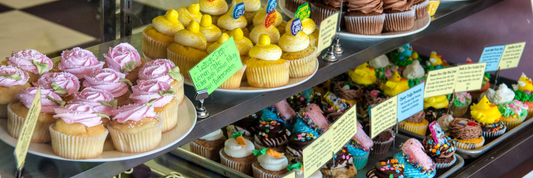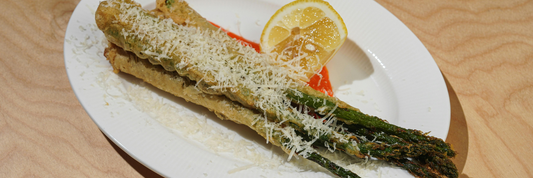The ramen market has evolved rapidly over the last few years, especially across Canada and North America. Diners today don’t just judge a ramen shop by the depth of its broth or the chewiness of its noodles they also evaluate the entire brand experience: the atmosphere, the visual identity, the packaging, and the values behind the business.
This article is written for ramen restaurant owners, small restaurant operators, and food entrepreneurs who feel their brand is no longer telling the story it once did or no longer connecting with the customers they want to serve.
As a partner to hundreds of foodservice operators, Kimecopak often sees how outdated branding or unsustainable packaging quietly holds ramen restaurants back. Through modern design and eco-friendly packaging solutions, Kimecopak helps elevate a restaurant’s identity without compromising authenticity or tradition.
If you’ve been wondering whether it’s time to refresh your ramen shop’s look and feel, these five signs will tell you exactly when a rebrand becomes not just beneficial but necessary.
-
Sushi Pricing Strategy: How to Compete with Big Restaurant Chains
-
Ramen Shop Checklist: Everything You Need Before Opening in Canada
-
Technology Applications in Ramen Shops: From Order Tablets to Kitchen Displays
Sign #1: Your Branding No Longer Reflects Your Menu or Concept

Menus change, but branding often doesn’t
It’s normal for ramen restaurants to evolve. Many start with classic tonkotsu or shoyu bowls, then gradually introduce spicy variations, vegan options, premium wagyu toppings, fusion ramen, or seasonal specials.
But the branding logo, color palette, menu design, packaging often stays frozen in time. This mismatch silently confuses customers.
Example:
A shop originally known for heavy, traditional broths may now focus on lighter, modern bowls with clean ingredients. But the brand still uses dark colors, heavy fonts, and glossy plastic packaging. Customers feel a disconnect, even if they can’t articulate why.
Signs your branding no longer fits your concept
-
Your menu feels modern, but your logo looks dated
-
Your packaging doesn’t match the visual identity on social media
-
You’ve repositioned your food but not the brand story
-
New customers misinterpret your concept (e.g., thinking you're traditional when you’re not)
How sustainable packaging elevates an updated positioning
When restaurants refresh their menu concepts, packaging becomes one of the quickest and most visible ways to communicate change.
Eco-friendly solutions such as kraft ramen bowls, compostable lids, and custom-printed soup cups can signal that your brand values quality and care.
Kimecopak supports rebranding with:
-
Minimalist kraft soup cups
-
Compostable ramen bowls
-
Custom-printed packaging for brand consistency
-
FSC-certified and sustainable materials
These touches help customers instantly understand your evolution before they even taste the broth.
Sign #2: Customer Engagement Has Dropped Noticeably

The silent signals that customers are losing interest
A decline in engagement might look like:
-
Fewer repeat customers
-
Lower foot traffic
-
Fewer comments or shares on Instagram or TikTok
-
Customers saying “it’s good” but not returning
-
Online reviews that mention atmosphere or overall experience, not the food
People don’t always tell you directly that your brand feels stale. They simply drift away.
What customers really mean when they say “everything is okay”
In the restaurant world, “okay” is dangerous. It means you’re not memorable.
Modern diners want brands that spark emotion comfort, authenticity, craftsmanship, or innovation.
When your branding no longer elicits that emotion, engagement drops quietly but steadily.
Refreshing touchpoints to reconnect with customers
A rebrand helps you refresh:
-
The storefront signage
-
Menu layout and typography
-
Take-out packaging (critical for modern ramen shops)
-
Social media visuals
-
Staff uniforms or tone of communication
A single updated element like switching from plastic soup bowls to premium kraft bowls can shift perception instantly.
Sign #3: Your Competitors Feel More Modern Than You

Ramen brands are modernizing fast
Across North America, new ramen shops embrace:
-
Minimalist Japanese aesthetics
-
Lighter branding with clean typography
-
Sustainable packaging concepts
-
Ingredient transparency
-
Community- and story-driven messaging
If your competitors look fresher, more modern, or more eco-aligned, customers will naturally gravitate toward them even if your food is objectively better.
How to identify a competitor gap
Ask yourself:
-
Does your restaurant look older compared to new ramen shops nearby?
-
Are competitors using eco-friendly packaging while you’re still using plastic?
-
Do their social media visuals feel curated, while yours feel outdated?
-
Do they promote a stronger brand story?
Eco-friendly packaging as a modern differentiation
Sustainability is no longer a trend it’s an expectation.
According to a report from McKinsey & Company, more than 60% of consumers prefer brands using sustainable packaging (source: McKinsey & Co., “Sustainability in Packaging 2023”).
Ramen restaurants adopting sustainable bowls and cups immediately appear more modern and forward-thinking.
Sign #4: Your Packaging Feels Outdated or Wasteful

Packaging is a core brand asset not an operational detail
Takeout and delivery now represent a large portion of revenue for ramen restaurants. In many cities, 40–60% of ramen orders come from third-party delivery apps. When packaging becomes the first physical touchpoint customers experience, it becomes part of the brand story.
If your packaging:
-
Leaks or becomes soggy
-
Looks cheap
-
Contains single-use plastics
-
Doesn’t match your brand style
-
Feels generic
…it may be time for an upgrade.
The shift to eco-friendly packaging is driven by real consumer demand
Customers today care deeply about sustainability.
A 2022 Statista survey found that 74% of consumers are willing to pay more for sustainable packaging (source: Statista, “Consumer Sustainable Packaging Preferences”).
Failing to modernize packaging doesn’t just hurt perception it directly affects revenue, especially among younger diners.
How Kimecopak helps ramen brands elevate packaging
Kimecopak specializes in premium, sustainable packaging solutions designed specifically for foodservice brands.
Popular ramen-friendly options include:
-
Compostable bowls for hot soups
-
Kraft soup cups with leak-resistant lids
-
Custom-branded noodle boxes
-
Certified compostable stickers & labels
-
PLA lids and plant-based materials
A packaging upgrade can be the centrepiece of your rebrand an immediate visual transformation customers can feel and trust.
Sign #5: Your Brand Story Doesn’t Resonate Anymore

Customers crave authenticity and meaning
Today’s diners want to connect with brands that stand for something not just serve food. A ramen restaurant’s brand story can reflect:
-
A family history
-
A cultural journey
-
A philosophy of simplicity
-
A passion for ingredients
-
A commitment to sustainability
-
A devotion to craft
If your current branding doesn’t express your story or tells an outdated one rebranding gives you a chance to rewrite it.
How a strong story influences customer loyalty
An authentic story…
-
turns first-time visitors into regulars
-
builds emotional attachment
-
drives word-of-mouth referrals
-
strengthens social media presence
Aligning your new story with sustainability
Sustainability is one of the most powerful narrative frameworks today.
By integrating eco-friendly decisions such as choosing compostable ramen bowls or recycled kraft containers you build a story that resonates with modern diners who value responsibility and authenticity.
How to Start Your Rebrand: A Step-by-Step Checklist

A rebrand doesn’t need to be overwhelming. Here’s a clear checklist ramen owners can follow:
Step 1: Audit your current touchpoints
Review:
-
Logo & visual identity
-
Menu design
-
Packaging
-
Website & social media
-
In-store experience
-
Customer feedback
Step 2: Identify gaps
Ask:
-
What feels outdated?
-
What no longer matches your concept?
-
What confuses customers?
-
Where do competitors outperform you?
Step 3: Refresh your visual identity
This could include:
-
New logo
-
Updated color palette
-
Minimalist typography
-
Modern interior accents
-
Updated plating style
Step 4: Upgrade your packaging
This is one of the most visible and cost-effective changes.
Kimecopak supports rebrands with:
-
Sustainable, high-quality materials
-
Premium food-safe printing
-
Custom designs aligned with your new brand
-
Fast turnaround times
Step 5: Relaunch your updated story
Share it through:
-
Website
-
Bio & captions on social media
-
Press releases
-
Partnerships with local creators
-
In-store signage
Step 6: Measure post-rebrand performance
Track:
-
Repeat customers
-
Average order value
-
Social engagement
-
Reviews mentioning “packaging,” “brand,” or “experience”
-
Delivery order ratings
Common Rebranding Mistakes to Avoid
1. Changing everything at once
A rebrand should feel refreshed not unfamiliar. Balance modernity with continuity.
2. Ignoring loyal customers
Explain the story behind your changes. It helps avoid confusion.
3. Choosing low-quality packaging
Cheap packaging undermines premium perception especially for ramen.
4. Rebranding without focusing on sustainability
Consumers increasingly expect eco-friendly practices. Missing this trend reduces brand relevance.
Why Sustainable Packaging Should Be Central to Your Rebrand

Sustainable packaging is no longer optional it’s part of brand identity, especially in foodservice.
Reasons to prioritize sustainability
-
Environmental responsibility
-
Improved brand perception
-
Alignment with consumer expectations
-
More premium visual presentation
-
Long-term cost efficiency
How Kimecopak supports ramen restaurant rebrands
-
Expert recommendations tailored to ramen shops
-
High-end packaging aesthetics
-
Compostable and recyclable materials
-
Wholesale pricing for scaling brands
-
Reliable supply for growing restaurants
Sustainability doesn’t just enhance your brand it protects it for the future.
Conclusion
Rebranding your ramen restaurant isn’t simply about updating visuals it’s an opportunity to redefine experience, strengthen identity, and future-proof your business in a highly competitive market.
Whether your brand feels outdated, your packaging no longer aligns with expectations, or your story no longer resonates, a strategic refresh can reignite customer loyalty and set your ramen shop apart.
And with premium, eco-friendly packaging solutions, Kimecopak is here to help you build a brand that’s not only modern and memorable but deeply meaningful.
FAQ
1. How do you know when a restaurant needs rebranding?
When your branding no longer reflects your menu, customer engagement declines, competitors feel more modern, or your packaging is outdated.
2. How often should a restaurant update its branding?
Most restaurants revisit their branding every 5–7 years, or sooner if the market changes rapidly.
3. What is the cost of rebranding a small ramen restaurant?
Costs vary widely from a few thousand dollars for modest updates to more for full-scale redesigns.
4. Is sustainable packaging important in restaurant rebranding?
Yes. It strongly impacts customer perception and aligns with modern consumer expectations.
5. Should I change my logo when rebranding my ramen shop?
Not always. Some brands only update color palettes, typography, or packaging.
6. What are the best eco-friendly packaging options for ramen?
Compostable bowls, kraft soup cups, PLA lids, and custom-printed containers.
7. Can rebranding help increase restaurant revenue?
Absolutely. Strong branding influences customer loyalty, perceived value, and repeat purchases.




